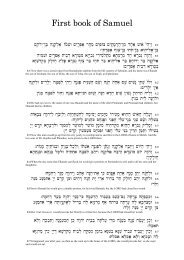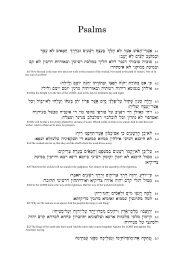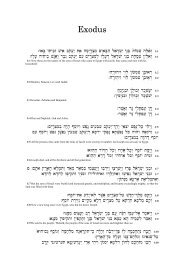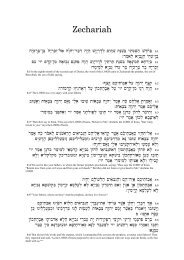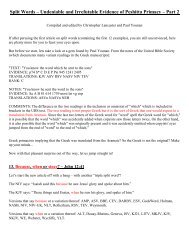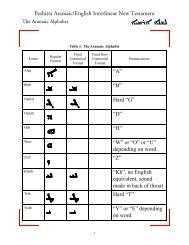ana translation
Untitled - Peshitta Aramaic/English Interlinear New Testament
Untitled - Peshitta Aramaic/English Interlinear New Testament
- No tags were found...
You also want an ePaper? Increase the reach of your titles
YUMPU automatically turns print PDFs into web optimized ePapers that Google loves.
xliv<br />
INTRODUCTION<br />
After Codd. 1 and 2 it will be convenient to disregard numerical<br />
order, and to pass on to the other MSS (9, 12, 14), which may be<br />
distinguished from 1 and 2 as forming a later subdivision of group A.<br />
Cod. 9. (Cambridge University Library, Oo. 1, t. 2.)*<br />
This is the second volume of the great Syriac Pandect (the "Buch<strong>ana</strong>n<br />
Bible"), which, though the vellum of which it is composed<br />
is much<br />
damaged by damp and decay, is one of the most notable monuments of<br />
Syriac Biblical antiquity. It was presented to the University of<br />
Cambridge by<br />
Dr. Buch<strong>ana</strong>n in 1809. The New Testament in it is<br />
complete, except that it lacks the Apocalypse. Though<br />
it exhibits our<br />
Four Epistles, it places them, not in their proper order, but together,<br />
subjoined to the Three of the Peshitta. It adds, however, a note in<br />
which it reckons them all together and on a par, as " The Seven<br />
Catholic Epistles of the Apostles." This tacit recognition<br />
canonicity is hardly weakened by<br />
of their<br />
the fact that next after them it<br />
places ' ' the Six Books of Clement," documents coinciding in the main<br />
with those which are known as the " Syrian Octateuch." f From this<br />
MS Dr. Lee J derived many corrections of the text of our Epistles, and<br />
of the Syriac New Testament at large, for his editions. It gives a<br />
general, but far from uniform, support to the text of Cod. 1, deviating<br />
now and then into the readings of the later MSS. But in no case<br />
does it follow 1 in its exceptional lapses (as noted above), save in the<br />
instance of the word .OOlAxK^J (see above, p.<br />
xlii ;<br />
also notes on<br />
2 Pet. ii. 13, Jud. 12 (Syr. text),<br />
and Note on p. 107 infr.).<br />
Its script is estrangela,<br />
of the modified form affected in the<br />
twelfth century in Tur 'Abdin, the district of N.E. Mesopotamia,<br />
* See Cambridge Catal. Syr. MSS, p. 1037.<br />
t For these six documents, see Journal of Theological Studies, vol. iii, pp. 59 et<br />
sqq., where Book 3 is printed by Dr. Arendzen, partly from this MS and partly from<br />
one at Mosul. It is the ' Apostolic Church Order ' (see Bishop Wordsworth's<br />
Ministry of Grace, p. 34), the Greek of which has been edited by Harnack and<br />
others. Books 1 and 2 are the Testament of Our Lord edited in Syriac by the<br />
Patriarch Rahmani (1899), in English by Dr. Cooper and Dean Maclean (1902).<br />
J See a memorandum by Dr. Lee, Classical Journal, vol. xxiii, p. 248, where<br />
he states that he collated it (" the Travancore MS ") for his Syriac N.T. of 1816.<br />
He notes that it is " a Jacobite copy," and remarks that it " could not have been<br />
brought into India earlier than 1663 " (referring to Assemani, B.O., t. in, pt. ii,<br />
p. 463, for the arrival of the Jacobites in India in that year). See also Milne Eae's<br />
Syrian Church in India, ch. xvii, p. 269.



